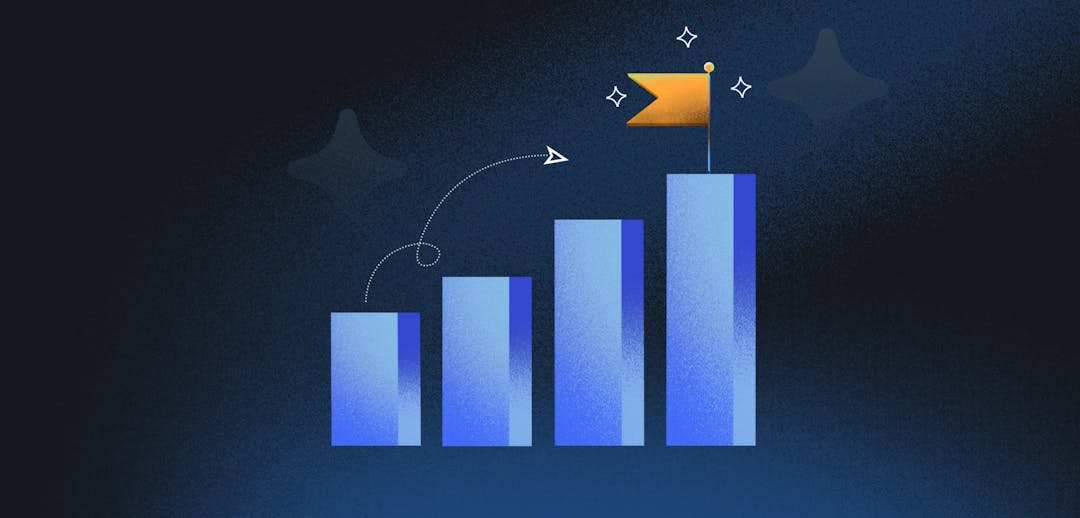Product-led growth (PLG) is great for growing the size of your customer base, while a sales-led approach focuses on the value of a customer. The question of the moment: what happens if and when you combine the two?
A hybrid approach is quickly becoming a bigger trend for software companies around the world who have seen early success through a product-led strategy - ones that want to scale up and take on new markets. It’s also drawing the attention of sales-led organizations that have borne witness to the successes of product-led businesses and want to cash in.
Let’s take a closer look at all the elements of PLG and SLG, and how they can all come together in one sweet mix for SaaS success. 🎂
What is the PLG and SLG hybrid model?
The hybrid approach is a go-to-market, growth, or customer acquisition strategy that takes on the elements of both product-led growth and sales-led growth.
The aim? To cover as much ground as possible in terms of your audience, focusing on their business goals and user preferences to attain optimum business growth. 🏆
What a hybrid business model can look like:
- Go-to-market: Startup combining both sales/customer acquisition motions from the get-go
- Moving downmarket: Sales-led with a product-led overlay
- Moving upmarket: Product-led with a sales overlay
The latter route of applying a sales overlay over a PLG approach is becoming increasingly popular with well-known PLG SaaS companies like Zoom, Slack, and Figma leading the way. It’s what ‘bottom-up’ growth looks like: You build your business by focusing on product value, usability, and reach, then work your way up from single customers to larger teams. Here’s where your sales team can step in.
A downmarket motion calls for you to introduce a version of your product and supporting infrastructure that self-sufficiently attracts, converts, and onboards smaller customers without undervaluing your original product. More on this to follow.
Four benefits of the hybrid sales motion:
So, let’s take a look at the benefits of going hybrid.
1) Combined benefits:
Both PLG and SLG have a string of benefits that come out to play in the hybrid motion. By combining both, the cons of each of their limitations are canceled out. Clever.
Here are some of the standout benefits that a hybrid model gets to make the most of:
Benefits of PLG:
- Lower costs (CAC, internal headcount)
- Widens top of funnel (esp. with self-serve)
- Helps you scale faster without the costs
- Tighter product feedback loops
- Positive customer experience*
Benefits of SLG:
- Target niche clients and their needs
- Increase your ACV
- Easy to *show* value via sales reps
- Identify upsell and cross-sell opps
- Stay close to your customers
*Around 67% of people would expect to see a self-serve approach 👀
3) Cost-effective for a full growth strategy
Going hybrid is the most cost-effective path for maximum growth. This is especially true if you’ve gone for the ‘bottom up’ growth strategy, with a sales-led approach overlaying your product-led growth.
How does that work, we hear you ask. Well, product-led growth is where your user acquisition, conversion, retention, and expansion rely on your product, right? This can be seen in the form of freemium, free trials, self-serve options, or just great customer service and support with relevant documentation so users can just learn themselves.
With that, you save a lot of $$$ on costs like headcount in sales and support, as well as customer acquisition costs, because customers are doing it for themselves.
But it doesn’t stop there. By overlaying SLG, you can easily define your target market or customers for your sales team to make sure they’re right for your business, and you're right for them.
3) Unlock a huge total addressable market (TAM)
Taking on both self-serve and sales-assisted approaches means that you’re covering all bases: upmarket (✔️ ) and downmarket (✔️ ).
That means those with a low budget – be they SMBs or individual users – can benefit from some of the value your product has to offer, supporting your brand and business through their sheer volume. Meanwhile, your sales team can nurture and interpret the demand of select high-value targets at a strategic or enterprise account level.
4) Build your product to its full potential
Both PLG and SLG encourage collaboration with your users, but in different ways.
Product-led growth revolves around the product driving its own revenue, meaning it has to be a great product with great documentation and support to match it. That means plenty of customer data to get your hands on, and use to evolve your product and service.
With sales-led growth, the sales team gets an idea of what specific businesses are looking for as a solution. Not only can they adapt their sales pitch to highlight the most relevant propositions, but they can use this to inform new additions to or priorities in the product roadmap.
And in doing so, you’ll maximize your growth opportunity. ✨
Examples of companies that adopted this strategy
Dropbox
Online storage and collab startup, Dropbox went along with the ‘bottom-up’ growth approach. Starting out with a PLG strategy meant they initially focused on a simple and straightforward product that met market demand. When they added features like shared folders and a referral scheme, their user base continued to grow – and at a more rapid rate.
The second step was a more specific focus on monetization, where the Dropbox sales team began to take advantage of the upmarket opportunities within their user base. Hello, SLG. This mixture of PLG and SLG meant they could make the most of every sales opportunity. And the rest, they say, is history.
You can hear GC Lionetti, the former CMO of Confluent and VP of Self-Serve Growth at Dropbox, talk about the hybrid go-to-market motion in this podcast.
Slack
Another big name that initially kept their product away from the traditional ways of sales-led growth is Slack. With a freemium model being its main growth lever, Slack knew it would need to convert freemium users to paying customers to gain revenue. That’s why they had feature restrictions, including a limited number of searchable messages per company, which made the conversion almost irresistible to most businesses.
Slack grew by grade-A customer experience and “obsessively listening to customers”; always testing, iterating, and learning. This meant they could both focus on perfecting their product to maximize virality to increase their downmarket potential, and easily identify key opportunities for corporate or enterprise sales.
Slack stats from 2021 tell us that they have 600,000+ organizations around the world that use the platform, with around 88,000 paying to use it.
Hubspot
Hubspot is an example of a business that initially took a sales-led approach to grow their business, but they soon realized the benefits of introducing PLG too. That’s when they introduced a freemium-style motion to their business as an overlay, which required a whole new team, and gained a whole new (down)market.
With the right training and communication around this new motion, Hubspot then transitioned to PLG as its core go-to-market strategy, honing in on the customer experience and journey to make a product their users can’t live without.
Some pretty successful companies, right? If your product sees enough traction, you’ll likely be following in their footsteps. It’s worth being aware of what going hybrid looks like in SaaS.
Three requirements of a hybrid approach
There’s no shortage of work to be done to make a success of a hybrid approach, whether you’re approaching the task from a sales-led or a product-led starting point. Here are three critical areas to consider:
New teams
Introducing PLG or SLG as an overlay to your original go-to-market strategy will require a whole new team to work on that element of growth, and prove the value of your product in their own way.
If you started out with PLG, you’re going to need to introduce business development and sales representatives to find and convert prospects. Your large accounts will need dedicated attention and support through implementation and adoption. Hello, customer success.
If you’re adopting a PLG motion from the starting point of being SLG, you’ll want to consider hiring into your support team to make sure those self-serve customers are never at a loss with your product. And likely into your engineering team, so you have resource to be continuously working on the user experience.
And don’t forget, with new teams come the challenges of onboarding, managing, and goal setting, to name a few. Not to mention the potential complexities of an international headcount, to cover local sales and support representatives in every territory (and language, and timezone) you sell to.
Product and packaging
Large businesses have different needs and expectations versus individual buyers, and your product will need to cater to them all. You’ll need to consider your value propositions, as well as how you package up and price your product’s features to work for each segment. The product itself will need configuring to serve customers the setup they’ve bought.
The different nature of the relationships you have with large customers compared to no-touch customers will have implications for your product roadmap and engineering resourcing. You’ll need to find the right balance between addressing the product asks of a few high-value accounts with investments that benefit the wider user base.
New tools
A new target audience and a new commercial team mean new processes and new tools. ✨
From CRM systems to product analytics tools, there are plenty of solutions to help you make a success of your hybrid motion. Many are critical ways of empowering your teams to work more efficiently and make better decisions.
The main challenge though? With multiple tools split across different channels, there’s no single source of revenue data truth. Bringing it together takes manual labor and time - and you can’t be sure it’s entirely accurate. This easily causes issues in your data and reporting.
Where to start?
Whilst this sounds like an overwhelming to-do list, you don’t have to solve it all at once, and you don’t need to build it all from scratch.
There are platforms out there that can provide you with the infrastructure and the expertise that will solve big bits of the puzzle that we mentioned above for you, and set you off to a flying start. Oh, and help you grow faster, and more efficiently, as a result.
Let’s have a look at how you can go about it:
New teams:
What to consider: Hiring and onboarding, including on an international basis.
What you need: A strong sales leader for the sales-led side of things, and a top-notch support and engineering team to make sure your users are having the easy breezy experience they need to buy and get the most of your product.
Tooling: An employer of record service, (eg. remote.com) to make the task of hiring internationally a lot easier for you.
Product and packaging:
What to consider: Product, packaging, and pricing to suit both your PLG and SLG audiences.
What you need: Insight into your customers and prospective customers and what they find valuable and ‘nice to have’ - include the largest clients for sales-led tips to the smaller customers in the market, who would go for a self-serve approach.
Tooling: Consider platforms like Survey Monkey and Wynter for customer surveys and for testing your messaging, as well as methods like A/B testing to help optimize your pricing.
New tools:
What to consider: The integration of all the tools and processes needed for a strong payments infrastructure.
What you need: Either a lot of time and a lot of painkillers for headaches, or tools that will relieve you of those complexities and challenges.
Tooling: Well, we might be biased here but… Paddle is an all-in-one solution for your payments and billing infrastructure, meaning you don’t need to worry about anything from your self-serve checkout or SLG invoicing, all the way through to reporting and unifying your data.
Our aim is to help software companies like you sell better, faster, billing, and safer. Find out more here.





